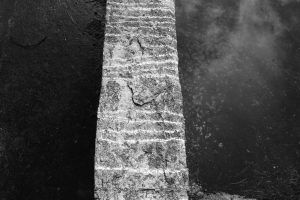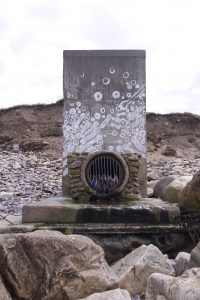Fig 1. Potential site for drawing. Dunmoran Strand, Sligo, Ireland.
The project titled Drawing Wonder: A phenomenological investigation into the Site Specific Drawing examines how site specific drawing has the capacity to create a sense of wonder in order to call attention to the ontological relationship between the subject [drawer and viewer] and the object [drawing] and the site. A phenomenological lens provides the philosophical context for this inquiry that is situated within the field of drawing research and practice. This project potentially contributes to drawing research through the concept of Holding Space which is posited as a practice research methodology that examines how marks are created through drawing as phenomenology and its relationship to site specific drawing. Drawing is understood phenomenally and as such, drawing has the capacity to bring forth the essence of a phenomena to allows us to know the world differently by grasping the world through felt experience (van Manen 2007, 268-271). That is to say, drawing has the capacity to describe and bring into view the felt and liminal experiences of the site and the drawing.
The theoretical considerations within this research project draws upon core phenomenologists who consider phenomenology, art and wonder; Martin Heidegger’s account of the ontology of art and his position on wonder, art and truth (1950, 1994), Max Van Manen’s account of a ‘phenomenology of practice’ where meaning is found in wonder (2014) and Maurice Merleau-Ponty’s account of embodiment, perception and the flesh (1968, 2005). Merleau-Ponty writes that we find the true meaning of phenomenology within ourselves (Merleau-Ponty 2005, viii). Therefore, to awaken a deep sense of wonder in the viewer, the drawer must first be filled with wonder and be empathetic to the lived experience of the site (Merleau-Ponty, 2005; van Manen 2014). By taking a phenomenological attitude in wonder, drawing becomes a device for perceiving and understanding the world as it appears.
Fig 2. Drawing from the Non-Place, 2017. Chalk on found concrete structure, Sligo, Ireland.
Fig 3. Drawing from the Non-Place, detail, 2017. Chalk on found concrete structure, Sligo, Ireland.
Particular sites were chosen only if they provided a sense of wonder and if they were located on or near public walking areas. The project seeks to test the researcher’s prior investigations into site specific drawing (Fig 2, Fig 3. Fig 4) by omitting the initial drawing process of using pencil on paper in order to become attentive to the site and also to test alternative drawing sites. The researcher will draw directly onto the surface of the site while being open and receptive to the phenomena of the drawing material, the surface and the site.
Fig 4. Drawing from the Non-Place II, 2017. Chalk on found concrete structure, Sligo, Ireland.
Academic and practitioner Deborah Harty richly articulates the lived experience of the drawing process and notes that within the drawing process, states of awareness oscillate between the environment as background to a heightened sense of awareness of mark making (Harty, 2015, p.56). As a record of an experience, the drawings describe this shifting of awareness that evinces the immaterial into the material. The project seeks to create new and unexpected marks that records a perceptual experience with the knowledge that the drawing will offer only a singular aspect of that experience. The project posits that the drawing on the site’s surface physically and conceptually grounds the drawing in the site and does not depict nor hide a surface but draws attention to the surface of the site as content and context.
The researcher posits that the drawing’s materiality will guide the viewer past aporia and encourage them to dwell in wonder as the truth of the phenomena is revealed. In this respect, the research adheres to Heidegger’s view (1994) of truth as not as a propositional truth as ‘correctness’ but is restored to its fundamental form as truth as aletheia. There is no attempt to create representative or illusionary drawings, rather, the goal is ambiguity itself: an uncertainty, an indefinite space where wonderment may be sustained. The drawing doesn’t facilitate a representation of an aspect of human life but opens up a different realm on human existence. The research posits that the simplicity and accessibility of the materials ensure the drawing avoids any sense of awe or curiosity.
The project poses that the ambitious gestural marks, as a disclosure of human presence, may disrupt any attempt by the viewer to cognitively grasp the meaning of the drawing. By loosening the “intentional threads which attach us to the world” (Merleau Ponty, 2005, p.xv) the drawing may hold the perceiving subject’s attention in wonderment because it lays the groundwork to “reawaken the basic experience of the world, “(van Manen, 2011). In other words, within the Holding Space of wonder, the drawing seeks to find the “manifold layers of the experience of objectivity through the heart of subjectivity” (Moran and Mooney 2002, 2). In doing so, it is posited that the reciprocal relationship between the drawer, the drawing, the viewer and site become present to one and other.
Artists website: https://www.kieraotooleartist.com
Bibliography
GREGORY. . B.S., 2013. Martin Heidegger | The Origin of the Work of Art (part 1-3), Existentialist Philosophy & Literature., [online] [viewed 01 January 2018]. Available form: https://www.youtube.com/watch?v=VmGP1aesJyg
HANSEN. F.T. 2015, The Call and Practice of Wonder: How to Evoke a Socratic Community of Wonder in Professional Settings.In: WEISS.M.N., ed. The Socratic Handbook: Dialogue Methods for Philosophical Practice. Germany: LIT Verlag. Vol. 9. P. 217-244.
HARTY. D.J., 2009, Drawing//experience, a process of translation. Thesis (PHD).
Loughborough University Institutional Repository
HARTY, D.J., 2012. drawing//phenomenology//drawing, an exploration of the phenomenological potential of repetitive processes. TRACEY. January. Available form:
http://www.lboro.ac.uk/departments/ac/tracey/ tracey@lboro.ac.uk
HARTY, P.J. and SAWDON, P.J., 2016. Interweaving in hybrid methodologies. Journal of Visual Art Practice, 15(1), pp.30-40.
HARTY, D.J., 2015. Trailing temporal trace. In: SAWDON, P. and MARSHALL, R. eds. Drawing Ambiguity: Beside the Lines of Contemporary Art. London: I.B. Tauris & Co. Ltd. (p. 51-65)
HEIDEGGER, M., 1994. Basic Questions of Philosophy: Selected “Problems” of “Logic” (Studies in Continental Thought). trans. by ROJCEWICZ, R. and SCHUWER, A. Bloomington & Indianapolis: Indiana University Press.
HEIDEGGER, M., 1962. Being and Time. trans. MACQUARRIE, J. & ROBINSON, E.
New York: Harper Collins Publishers
Heidegger, M., 2002., The Origin of the Work of Art. In YOUNG. J. And HAYNES. K. J. eds. Off the Beaten Track. trans. YOUNG. J. And HAYNES. K. J. Cambridge: Cambridge University Press. pp.1-56.
KWON, M., 2004. One Place After Another, Site Specific Art and Locational Identity. Cambridge, Massachusetts, London, England: Mit Press.
LODEWIJKS, B., 2016. Sligo Drawings. Amsterdam: Roma Publications 262.
MERLEU-PONTY, M., 2005. (reprinted) Phenomenology of Perception. trans. SMITH, C. London, New York: Routeldge.
MERLEU-PONTY, M.,1964. The Primacy of Perception: and other Essays on Phenomenological Psychology, the Philosophy of Art, History and Politics. trans. EADIE, J. M. Evanston, Illinois: Northwestern University Press.
MERLEU-PONTY, M., 2007. TOADVINE. T. and LAWLOW. L. eds. The Merleau-Ponty Aesthetics Reader. Evanston: Northwestern Univ. Press. P351-378.
MERLEAU-PONTY, M., 2004. The World of Perception, Oxford, New York: Routledge.
MERLEU-PONTY, M., 1968. The Visible and the Invisible. LEFORT. C. ed. trans. LINGIS. A. Evanston, Illinois: Northwestern University Press.
MORAN. D. and MOONEY, T., eds, 2002, The Phenomenology Reader. London, New York: Routledge.
TAYLOR, A., 2008. Re: Positioning Drawing. In GARNER, S. ed. Writing on Drawing, essays on Drawing Practice and Research. Bristol, Chicago: Intellect Books. pp. 9-12.
VAN, MANEN. M., 2014. Phenomenology of Practice, Meaning-Giving Methods in Phenomenological Research and Writing. Walnut Creek, CA: Left Coast Press, Inc.
VAN MANEN, M., 2011.Traversing: To write is to traverse the writerly space of the text. [online] [viewed 01/10/17]. Available from: http://www.phenomenologyonline.com/inquiry/writing/traversing/
YOUNG. J., 2011. Heidegger’s Philosophy of Art. Cambridge University Press.








